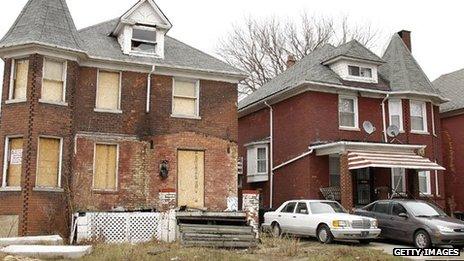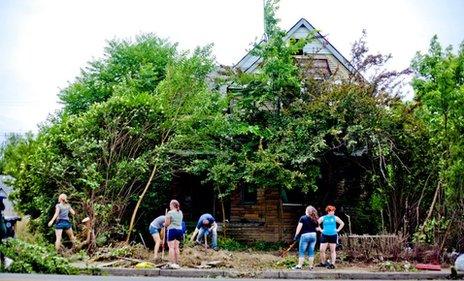Detroit: Six ways 'shrinking' cities try to survive
- Published

Detroit's bankruptcy can in part be traced to the loss of more than a million residents. So how have other "shrinking" US cities coped?
The problems that have led Detroit to bankruptcy are multiple - industrial decline, huge pension bills, over-borrowing and poor management among them.
But losing 1.2 million people since the 1950s would send any city into crisis. As the jobs and the inhabitants went elsewhere, the city was left with plummeting tax receipts, rising crime and derelict streets .
Other cities in the Rust Belt have also lost huge proportions of their populations. What have they done about it?
1. Demolish derelict buildings...
Some cities have developed a demolition industry, mindful that abandoned homes fuel vandalism, blight neighbourhoods and deter new arrivals.
Youngstown, Ohio, has lost 120,000 residents since the 1950s, now down to 66,000 people. In the last six years, it has pulled down 4,000 homes, says councillor Janet Tarpley, who represents the sixth district, where much of this demolition has taken place.

"Crime has been reduced since we have been tearing down homes," she says. "Some of them were being used to launder stolen goods and run prostitution and drugs rings. Squatters were moving in and just staying. So the quality of life has improved for many residents."
The area looks a lot better than it did in 2008 when she took office, says Tarpley, who knocks on doors and tells residents to cut their grass when it looks unsightly. Those who don't comply get a visit from a council lawnmower and have to pay the costs.
But the large-scale demolition has its critics. For a start, it's expensive - about $10,000 (£6,550) a house. And some residents say it has wiped out neighbourhoods and prevented property developers from investing. "Trees don't pay taxes" is the mantra of some opponents to demolition.
2. ...and sell the land for $25
Imagine you get a knock on your door and someone is offering you all the land next door - for just $25 (£16).
That's what has happened in Flint, Michigan, where the population is half what it was 50 years ago. In 2002, Flint-born Dan Kildee, now a congressman, set up a system there called land banks, which take ownership of derelict private properties.

"There's an abandoned house on a street," he explains. "We get that property through tax foreclosure, when the owner stops paying taxes. Instead of auctioning it off to somebody on the internet, we put it in the land bank.
"And because we have too many houses in a city that's lost lots of population, we bite the bullet and demolish this abandoned structure that's obsolete. We knock on the door of the next door neighbour, who's been paying a heavy price of living next door to this abandoned house. And for just $25, we sell that next door lot after it's been cleaned."
So instead of having a family home next to a big, empty reminder of what was once there, he says, there is a house with 80-foot (24-metre) grounds, upon which the family may build a garage, a playground or a driveway. "It's a productive part of the landscape."
3. Accept that smaller can be better
"That's a very tough thing for Americans to get their head around," says Kildee, who in 2010 co-founded the Center for Community Progress, which helps rebuild urban neighbourhoods.
"The very psyche for the American people was based on westward expansion, our manifest destiny. Growth and prosperity were the same thing.
"But that means very little to a person living in a city that has lost population and is not likely to regain it. We need to rethink how we define prosperity."
4. Build institutions

Pittsburgh is widely held up as a success story in reinvention, hosting the G20 summit in 2009, but it's cashing cheques that were written 50 years ago, says Professor Michael Madison from the University of Pittsburgh.
The Allegheny Conference on Community Development (the ACCD) was formed in the 1940s, when some leading steel industry players joined with the city of Pittsburgh and Allegheny County to address some of the city's most pressing environmental and infrastructure issues.
For instance, they banned coal-burning furnaces in homes, to clear the air of smoke, and they created the Port Authority.
"There was a collaborative spirit back in the 50s and they knew that Pittsburgh would have to reinvent itself. They didn't know how but put in motion something that we are still benefiting from today," says Madison.
The city's two world-renowned universities, and its $10bn medical centre, also received significant sums of money in the 1950s and 60s.
Other cities should identify legacy institutions from the industrial era that could provide some skeletal backbone to future prosperity, he adds.
5. Don't be trapped by history
Pittsburgh was known as the Steel City so the steep decline of its steel industry was a huge blow to its identity.
A community needs a dynamic relationship with its history and to take advantage of the strengths of its history without being captive to it, says Madison.
"Pittsburgh needed to put a healthy and respectful distance between its modern self and its 20th Century steel self. Everyone loves the steel history but accepts it's not going to come back."

The history lives on in the American football team
6. Entice the right jobs
When the steel industry collapsed, the instinct of economic leaders in Pittsburgh was to reach out to other industries that could replace these kinds of jobs on a large scale, says Madison. The goal was more big factories making televisions or cars, a magic bullet solution.
But these are very competitive industries and most of the investment in these areas has gone to Asia or cheaper parts of the US, he says.
"It took Pittsburgh a while to realise that's a high-stakes strategy and we kept losing," says Madison. Instead it began to focus on service industries, the universities, the medical centre and hi-tech business, and growing jobs locally rather than importing them.

A group called Foster the Future has worked on derelict buildings in Detroit
You can follow the Magazine on Twitter, external and on Facebook, external